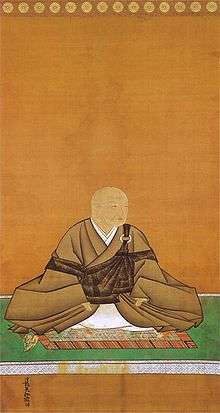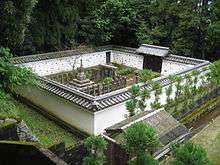Emperor Go-Mizunoo
| Go-Mizunoo Mizunoo II | |||||
|---|---|---|---|---|---|
| Emperor of Japan | |||||
 Go-Mizunoo | |||||
| Reign | 9 May 1611 – 22 December 1629 | ||||
| Predecessor | Go-Yōzei | ||||
| Successor | Meishō | ||||
| Born | 29 June 1596 | ||||
| Died | 11 September 1680 (aged 84) | ||||
| Burial | Tsuki no wa no misasagi (Kyoto) | ||||
| Spouse | Tokugawa Masako | ||||
| Issue | |||||
| |||||
| House | Edo period | ||||
| Father | Go-Yōzei | ||||
Emperor Go-Mizunoo (後水尾天皇 Go-Mizunoo-tennō, 29 June 1596 – 11 September 1680) was the 108th Emperor of Japan,[1] according to the traditional order of succession.[2]
Go-Mizunoo's reign spanned the years from 1611 through 1629.[3]
This 17th-century sovereign was named after the 9th-century Emperor Seiwa[4] and go- (後), translates as "later", and thus, he could be called the "Later Emperor Mizunoo". The Japanese word go has also been translated to mean the "second one", and in some older sources, this emperor may be identified as "Mizunoo II".
Genealogy
Before Go-Mizunoo's accession to the Chrysanthemum Throne, his personal name (his imina) was Kotohito (政仁)[5] or Masahito.[6]
He was the third son of Emperor Go-Yōzei. His mother was Konoe Sakiko, the daughter of Konoe Sakihisa.
He resided with his family in the Dairi of the Heian Palace. The family included at least 33 children; and four of them would occupy the throne.[7]
- Chūgū: Tokugawa Masako (徳川和子, 1607–1678), later known as Tōfuku-mon'in (東福門院),[8] daughter of Tokugawa Hidetada[7]
- First Princess Okiko (女一宮興子内親王 Onna-ichi-no-miya Okiko Naishinnō, 1624–1696), became Empress Meishō
- Second Princess (女二宮 Onna-ni-no-miya, 1625–1651)
- Prince Sukehito (高仁親王 Sukehito Shinnō, 1626–1628)
- Prince Waka (若宮 Waka-no-miya, 1628)
- Princess Akiko (昭子内親王 Akiko Naishinnō, 1629–1675)
- Princess Yoshiko (賀子内親王 Yoshiko Naishinnō, 1632–1696)
- Princess Kiku (菊宮 Kiku-no-miya, 1633–1634)
- Lady-in-waiting: Yotsutsuji Yotsuko (四辻与津子, d. 1639), later known as Meikyō'in (明鏡院)
- Prince Kamo (賀茂宮 Kamo-no-miya) 1618–1622
- Princess Ume (梅宮 Ume-no-miya) 1619–1697, later known as Queen Bunji (文智女王)
- Lady-in-waiting: Sono (Fujiwara) Mitsuko (園光子) 1602–1656, later known as Mibu'in (壬生院), daughter of the Minister of the Left Dainagon Sono Mototada
- Tsuguhito, Prince Suga (素鵞宮紹仁親王 Suga-no-miya Tsuguhito Shinnō, 1633–1654), became Emperor Go-Kōmyō
- Prince Morizumi (守澄法親王 Shyūchyōhō Shinnō, 1634–1680), in 1654, becomes abbot of Kan'ei-ji in Ueno, known as Rinnōji no miya.[9]
- Princess ? (? ?, 1637–1662), later known as Queen Genshō (元昌女王)
- Princess Tani (谷宮 Tani-no-miya, 1639–1678), later known as Queen Sōchō (宗澄女王)
- Princess Katsura (桂宮 Katsura-no-miya, 1641–1644)
- Lady-in-waiting: Kushige (Fujiwara) Takako, daughter of Sa Konoe Chūjō (左近衛中将,Vice-Secretary of left Imperial Guard).
- Teruko, Princess Ake (光子内親王 Ake-no-miya Teruko Naishinnō, 1634–1727), artist
- Nagahito, Prince Hide (秀宮良仁親王 Hide-no-miya Nagahito Shinnō, 1638–1685), became Emperor Go-Sai
- Yasuhito, Prince Hachijō (八条宮穏仁親王 Hachijō-no-miya Yasuhito Shinnō, 1643–1665), later adopted into the Katsura-no-miya princely house.[10]
- Lady-in-waiting: Sono (Fujiwara) Kuniko, daughter of the Naidaijin (later known as the Lord Keeper of the Privy Seal)
- Satohito, Prince Ate (高貴宮識仁親王): became Emperor Reigen
Events
Prince Masahito became emperor following the abdication of his emperor-father. The succession (the senso) was considered to have been received by the new monarch; and shortly thereafter, Emperor Go-Mizunoo is said to have acceded (the sokui).[11] The events during his lifetime shed some light on his reign. The years of Go-Mizunoo's reign correspond with a period in which Tokugawa Hidetada and Tokugawa Iemitsu were leaders at the pinnacle of the Tokugawa shogunate.
- 29 June 1596: The birth of an Imperial prince who will become known by the posthumous name of Go-Mizunoo.[12]
- 20 May 1610 (Keichō 15, 27th day of the 3rd month): Toyotomi Hideyori came to Miyako to visit the former-Shogun Tokugawa Ieyasu; and the same day, Go-Yōzei announced his intention to renounce the throne.[13]
- 9 May 1611 (Keichō 16): In the 26th year of Go-Yōzei-tennō 's reign (後陽成天皇二十六年), he abdicated; and the reign of Emperor Go-Mizunoo is considered to have begun.[12] The young emperor was aged 16.[14]
- 1614 (Keichō 19): Siege of Osaka. Shogun Tokugawa Hidetada vanquished Toyotomi Hideyori and set fire to Osaka Castle, and then he returned for the winter to Edo.[3]
- 26 November 1614 (Keichō 19, 25th day of the 10th month): There was a strong earthquake. The same year a great bell for the Daibutsu Temple in Kyoto was cast.[6]
- 1615 (Keichō 20): Osaka Summer Battle begins
- 1615 (Genna 1): Tokugawa Ieyasu and his son, Shogun Hidetada, marched again to Osaka Castle, which was captured and burned. Hideyori committed suicide. However his body was never found; it was rumored that he fled to Satsuma, where he had prepared a refuge in advance.[6]
- 6 January 1616 (Genna 2, 17th day of the 4th month): Ieyasu died at Suruga.[6]
- 25 September 1617 (Genna 3, 26th day of the 8th month): Former-Emperor Go-Yōzei died. He is buried at the North Fukakusa Burial Mound (深草北陵 Fukakusa no Kita no Misasagi).
- 1620 (Genna 6): Tokugawa Masako, the daughter of Shogun Hidetada, entered the palace as a consort of the emperor; and the marriage was celebrated with great pomp.[15]
- 2 April 1620 (Genna 6, 30th day of the 2nd month): Severe fire in Kyoto.[6]
- 6 April 1620 (Genna 6, 4th day of the 3rd month): Severe fires in Kyoto.[6]
- 1623 (Genna 9): Tokugawa Iemitsu, son of Hidetada, came to the court of the emperor where he was created Shogun.[6]
- 25 October 1623 (Kan'ei 3, 6th day of the 9th month): Go-Mizunoo visits Nijō Castle, which was built in 1586 by Toyotomi Hideyoshi
- 1627 (Kan'ei 6): The "Purple Robe Incident" (紫衣事件 shi-e jiken): The Emperor was accused of having bestowed honorific purple garments to more than ten priests despite the shogun's edict which banned them for two years (probably in order to break the bond between the Emperor and religious circles). The shogunate intervened making the bestowing of the garments invalid. The priests which had been honored by the emperor were sent into exile by the bakufu.[7]
- 22 December 1629 (Kan'ei 6, 8th day of the 11th month): Go-Mizunoo abdicated.[12] The emperor renounced the throne in favor of his daughter, Okiko, on the same day that the priests of the "Purple Robe Incident" went into exile.[16] Okiko became the Empress Meishō.
For the rest of his long life, Go-Mizuno-in concentrated on various aesthetic projects and interests, of which perhaps the best-known are the magnificent Japanese gardens of the Shugakuin Imperial Villa.[7]

Go-Mizunoo's memory is honored at Sennyū-ji in Higashiyama-ku, Kyoto where a designated Imperial mausoleum (misasagi) is located. It is named Tsuki no wa no misasagi. Also enshrined are this emperor's immediate Imperial successors – Meishō, Go-Kōmyō, Go-Sai, Reigen, Higashiyama, Nakamikado, Sakuramachi, Momozono, Go-Sakuramachi and Go-Momozono.[18]
Kugyō
Kugyō (公卿) is a collective term for the very few most powerful men attached to the court of the Emperor of Japan in pre-Meiji eras. Even during those years in which the court's actual influence outside the palace walls was minimal, the hierarchic organization persisted.
In general, this elite group included only three to four men at a time. These were hereditary courtiers whose experience and background would have brought them to the pinnacle of a life's career. During Go-Mizunoo's reign, this apex of the Daijō-kan included:
- Kampaku, Kujō Yukiie, 1608–1612
- Kampaku, Takatsukasa Nobuhisa, 1612–1615
- Kampaku, Nijō Akizane, 1615–1619
- Kampaku, Kujō Yukiie, 1619–1623
- Kampaku, Konoe Nobuhiro, 1623–1629.[19]
- Kampaku, Ichijō Akiyoshi, 1629
- Sadaijin
- Udaijin, Konoe Nobuhiro, 1619.[14]
- Naidaijin
- Dainagon
Eras
The years of Go-Mizunoo's reign are more specifically identified by more than one era name or nengō.[6]
See also
Notes

- ↑ Imperial Household Agency (Kunaichō): 後水尾天皇 (108)
- ↑ Ponsonby-Fane, Richard. (1959). The Imperial House of Japan, pp. 113–115.
- 1 2 Titsingh, Isaac (1834). Annales des empereurs du japon, pp. 410–411.
- ↑ Emperor Seiwa, after his death, was sometimes referred to as Mizunoo (水尾) because this is the location of his tomb.
- ↑ Ponsonby-Fane, p. 9.
- 1 2 3 4 5 6 7 8 Titsingh, p. 410.
- 1 2 3 4 Ponsonby-Fane, p. 114.
- ↑ Ponsonby-Fane, p. 115.
- ↑ Ponsonby-Fane, pp. 114–115; Satow, Ernest Mason. (1881). A Handbook for Travellers in Central & Northern Japan, p. 408.
- ↑ Ponsonby-Fane, p. 115
- ↑ Titsingh, p. 410; Varley, H. Paul. (1980). Jinnō Shōtōki, p. 44; n.b., a distinct act of senso is unrecognized prior to Emperor Tenji; and all sovereigns except Jitō, Yōzei, Go-Toba, and Fushimi have senso and sokui in the same year until the reign of Emperor Go-Murakami.
- 1 2 3 Meyer, Eva-Maria. (1999). Japans Kaiserhof in der Edo-Zeit, p. 186.
- ↑ Titsingh, p. 409.
- 1 2 Ponsonby-Fane, p. 113.
- ↑ Ponsonby-Fane, p. 113; Titsingh, p. 410.
- ↑ Ponsonby-Fane, p. 114; Titsingh, p. 411.
- ↑ Titsingh, p. 414; Meyer, p. 186.
- ↑ Ponsonby-Fane, p. 423.
- ↑ 近衛家(摂家)
References
- Meyer, Eva-Maria. (1999). Japans Kaiserhof in der Edo-Zeit: unter besonderer Berücksichtigung der Jahre 1846 bis 1867. Münster: LIT Verlag. ISBN 978-3-8258-3939-0; OCLC 42041594
- Ponsonby-Fane, Richard Arthur Brabazon. (1959). The Imperial House of Japan. Kyoto: Ponsonby Memorial Society. OCLC 194887
- Satow, Ernest Maston. and A. G. S. Hawes. (1881). A Handbook for Travellers in Central & Northern Japan: Being a guide to Tōkiō, Kiōto, Ōzaka and Other Cities .... Yokohama: Kelly & Co. OCLC 16846380
- Titsingh, Isaac. (1834). Nihon Ōdai Ichiran; ou, Annales des empereurs du Japon. Paris: Royal Asiatic Society, Oriental Translation Fund of Great Britain and Ireland. OCLC 5850691
- Varley, H. Paul. (1980). Jinnō Shōtōki: A Chronicle of Gods and Sovereigns. New York: Columbia University Press. ISBN 978-0-231-04940-5; OCLC 59145842
See also
| Regnal titles | ||
|---|---|---|
| Preceded by Emperor Go-Yōzei |
Emperor of Japan: Go-Mizunoo 1611–1629 |
Succeeded by Empress Meishō |
